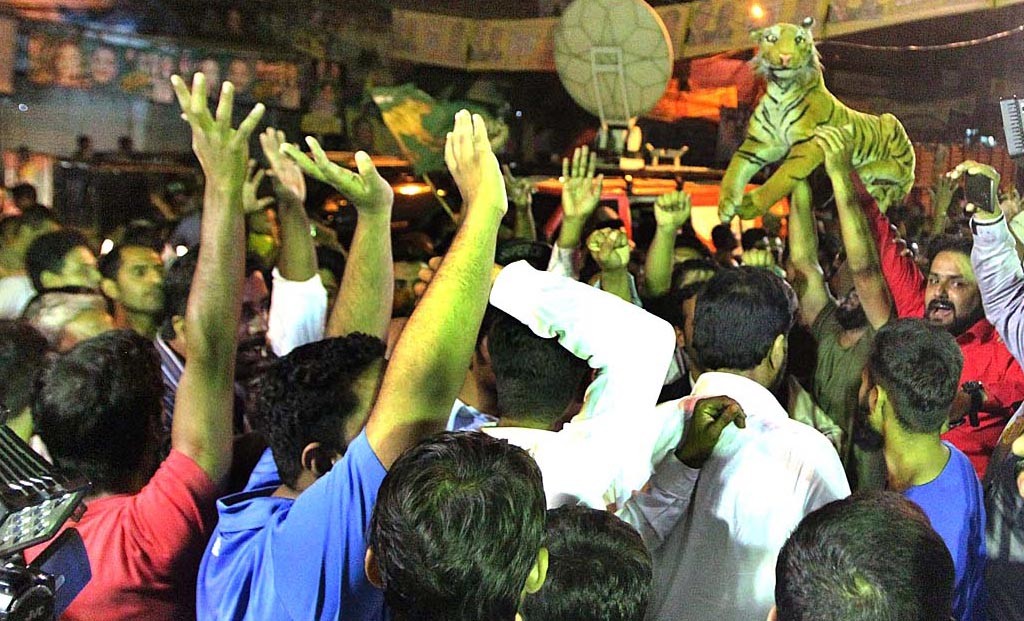
One big message from the PP-20 election is that politics seems irrevocably influenced by religion

Pakistan Muslim League-Nawaz (PML-N) recently won the PP-20 by-election in Chakwal. The seat fell vacant with the death of its loyalist member of provincial assembly (MPA), Chaudhry Liaquat Ali, who had retained this constituency since 1985 except for the 2002 election. The PML-N candidate, Chaudhry Haider Sultan, son of the deceased, secured 75,985 votes as opposed to the Pakistan Tehreek-e-Insaf’s (PTI) Raja Tariq Kalas, who bagged 46,025 votes. The third place was claimed by the Tehreek-e-Labaik Pakistan (TLP) with 16,577 votes.
The PTI’s vote rose from 32,000 to 46,000 when compared with the 2013 election. There are signs of the PTI vote surge which the PML-N electoral strategists would ignore at their own peril.
However, what really stands out from the PP-20 by-election are the 5,332 votes in favour of the TLP, especially considering that the city is supposed to represent an urban and educated spectrum of the constituency.
This is by far the highlight of the election and a foretaste of things to come.
Although Chakwal is overarchingly Barelvi with a considerable chunk of voters tied to various gaddis and pirs, the consolidation of this vote in a political block is not a good sign at a time when the right-left binary has collapsed altogether. Tahir-ul-Qadri’s party has previously received some of the Barelvi vote, but not at the scale Labaik has fortified in the recent election.
If the PP-20 result is extrapolated to the National Assembly seats in Chakwal then the PML-N and other political parties have a serious cause for worry.
The ongoing debate in Chakwal is about which party has been more damaged by the TLP’s vote surge. One view is that the TLP vote has cut into the PTI’s vote. The evidence presented is of PTI’s poor performance in its previous stronghold of Murid where the TLP vote saw a huge spike.
Others maintain that the PML-N is the net loser with its less than expected share of votes in the Chakwal city. This view rests on the premise that Sardar Ghulam Abbas’ insertion into the PML-N ranks should have boosted its vote share by 34,000. In 2013, Sardar Ghulam Abbas’ supported candidate in the PP-20 had bagged 34,000 votes. These votes should have migrated to the PML-N in the by-election, but didn’t. Some of these votes have likely gone to the TLP.
In the absence of a scientific study to trace out Sardar Abbas’ votes to the PML-N pool, it is reasonable to say that the TLP vote might have cut into both parties, more so in the case of PML-N. Many voters seem to have heeded the calls of pirs and gaddi nashins to vote for the TLP, thus trumping party loyalty to both the PTI and PML-N.
During the election campaign, it was apparent that the TLP was going about its business in a relaxed manner. The result showed that the vote was spread out widely across the constituency.
Some think that these votes are a passing phase, largely the result of the Faizabad dharna. But there are many reasons to understand this TLP vote base as something sustainable. One, Khadim Hussain Rizvi is far more energetic, focused on ramping up Barelvi vote and better at it than Tahir-ul-Qadri, who has wider personal and global ambitions. Two, Tahir-ul-Qadri has a narrow focus; he only works with his short-term goal of rousing up his followers once or twice a year. He is not likely to pitch his tent to implement the establishment’s will. Three, Rizvi is based in Pakistan and has full time interest in his constituency which fits in with the plan of a divided mandate and a hung parliament for the next election. Four, Rizvi is a better communicator and has cultivated a powerful local force to serve his agenda, helped by some elements of the establishment. All this also seems to have contributed to the TLP’s turnaround in Chakwal.
The establishment’s plot to fracture the PML-N vote may work if the result of PP-20 is a sign of things to come. If this trend repeats itself across Punjab, the marginal constituencies where the PML-N has a wafer-thin majority are susceptible to swing in favour of the PTI. This swing may deliver a dent to the PML-N’s claim to form a government at the centre. The plan may work because Rizvi’s rival is a determined fighter and crowd puller.
Beyond these calculations one big message from the PP-20 election is that politics seem irrevocably influenced by religion, with disastrous consequences. This was on ample display in Chakwal where each candidate outdid the other in asserting undying loyalty to mullahcracy and demonisation of Ahmadis, some going so far as to suggest that Ahmadis should be banished from Pakistan. This does not augur well either for stable democracy or for peaceful co-existence.